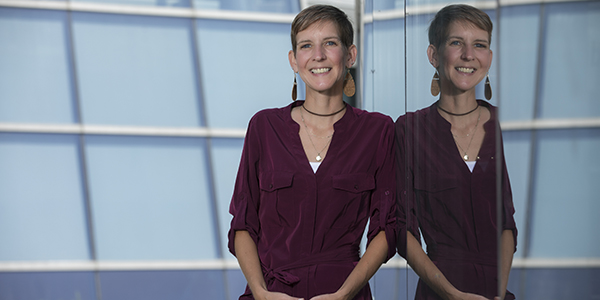Binghamton University faculty awarded $1.5 million grant to fund youth makerspace research

Makerspaces — collaborative workspaces where people work together on projects using both high and no-tech tools — have become increasingly popular in recent years. A new $1.5 million grant awarded to Binghamton University faculty could help improve makerspace learning for youths and help them find support during moments of failure.
“Shock would be the best way to describe it,” said Amber Simpson after she found out she was chosen for the research grant. An assistant professor in the Department of Teaching, Learning and Educational Leadership, Simpson was awarded a $1.5 million grant from the National Science Foundation to take place over three years.
The project will “address the gap through adapting, implementing and refining a professional development program for informal educators to productively attend, interpret and respond to youths’ experiences with failure while engaged in maker programs.”
Simpson holds workshops within the community to develop makerspaces for kids. She taught a “making and tinkering” class and the students worked with Your Home Public Library in Johnson City and Windsor Central Middle School. Students working with the library developed a project in which they spent one night a week helping youths make remote controls using Makey Makey invention kits that provide hands-on lessons on circuitry and conductivity — and then built video games using an online program that introduced basic coding. At the middle school, her students came up with similar making and tinkering activities to do during a weekly after-school program in the school’s new makerspace, a converted section of their library.
Simpson sees a lot of value in the makerspace world. “It doesn’t have to happen in four walls,” she said. “It could happen anywhere.” From recyclable material to pinecones, Simpson expressed the value in this new and more accessible way for kids to learn.
Kids and families are engaging in STEM content without them even knowing and it’s almost hidden in what they are doing, she added. “For example, I see a lot of informal measurement happening. It may not be what’s considered ‘school math,’ but they are using their knowledge and engaging in these STEM practices in a way that school may or may not be supporting them.”
Simpson is also hoping to take makerspaces to an online module because of the COVID-19 pandemic. “We are actually trying to examine how to build a community of practice through an online format,” Simpson said. “Some of our aims have shifted a little in the current landscape.”
Due to COVID-19, the need for youth makerspaces in homes and communities has grown. Simpson said she wants to shift the focus for kids from just Zoom learning to different activities. She hopes to help kids see that their home environment is a makerspace that will enhance and support what they are learning in school.
Another large part of Simpson’s research revolves around the notion of failure and the importance of failure within the learning process. She said that failure is not such a bad thing. Kids often find it detrimental within their school environment, yet they have a more positive attitude toward failure in makerspaces.
“When I think about the makerspaces, I don’t think kids even see it as failure,” Simpson said. “How people view failure is different based on the context they are in.” She expects a large shift in the learning process when the understanding of failure is more prominent.
Simpson’s core partners in this research are The Tech Museum of Innovation, The Bakken Museum, Montshire Museum of Science, The Minneapolis Institute of Art, Thinkery and Amazeum Children’s Museum. Adam Maltese at Indiana University and Alice Anderson at Minneapolis Institute of Art are co-principal investigators on the grant. Simpson said Maltese and Anderson will develop a professional development model based upon the instructional moves of educators when kids fail and then take the model and distribute it widely. “Their role is figuring out how to take the professional development model and adapt it to be more sustainable and have a larger reach,” Simpson said.
The funding, Simpson explained, will be used to support their partnering sites. “Dissemination is a huge part of this, doing workshops at other museums as we continue,” Simpson said.
A lot of trial and error will be involved. “We will try things out in the short term, tweak things in the short term,” Simpson said. “But hopefully by the end of the grant, it’s more of a model that will work for more individuals.”

